Results 1 to 10 of 10
Hybrid View
-
02-13-2016, 04:41 AM #1Senior Member



- Join Date
- Dec 2014
- Location
- Virginia, USA
- Posts
- 2,224
Thanked: 481 Fun with 200x Microscope & cell phone camera
Fun with 200x Microscope & cell phone camera
I got a pocket 200x microscope that clips onto my cell phone. Tonight I set about playing with the hones. For control purposes, the Norton hone got the same number of strokes (about 100) as the slates. First pic - Norton 8K on a Dovo Best:
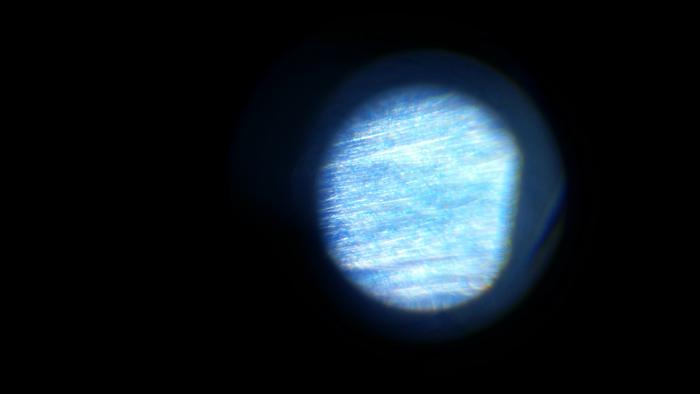
Next in line - Torrey, 2 stone progression, Norton 1k to Dragon's Tongue Welsh slate:
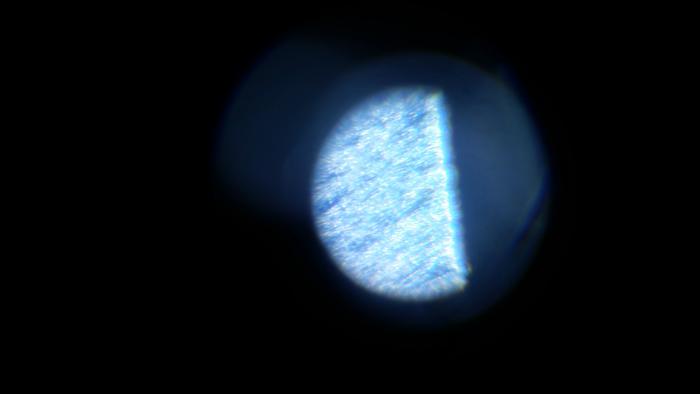
I would say that is as good as, if not arguably better than the Norton 8K. I have a trick up my sleeve to polish that a little better still. This is after using a heavy slurry to polish out the 1k scratches, and diluting from there. Finish was 50 strokes on the polished side, pure water.
After that, I worked on my Germania Cutlery Works. Dropped it back to the Norton 4k to true up the edge, worked that away with the Dragon's Tongue, then moved on to the Lynn Melynllyn slate. 50 strokes light slurry, 50 water:
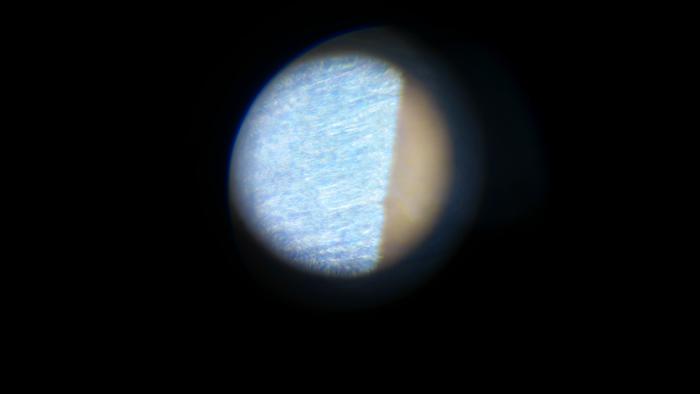
Pretty solid improvement over the Dragon's Tongue in my opinion. Also, it's interesting to see the difference in cutting action between synthetic and natural hones.
Last one I worked on tonight was the Morley clover. Worked out some rough bits on the edge with the Norton 4K. Dragon's Tongue to polish out the 4k scratches, then progressed through the Lynn Melynllyn on to the "Welsh Thuringian." 50 strokes light slurry, 50 pure water:
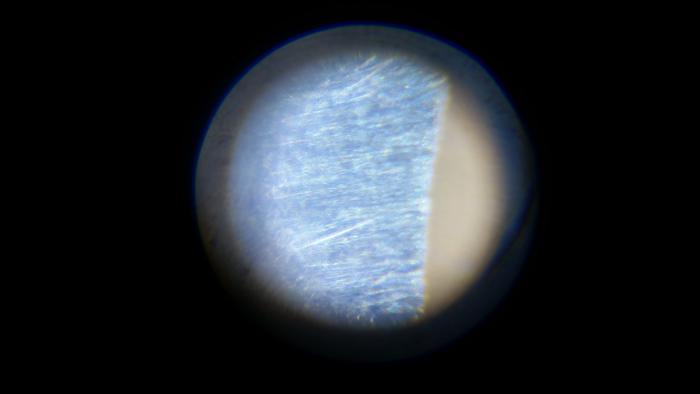
This was the point I discovered the microscope works MUCH better without the cell phone case adding extra space.
And the final pic for the night, a Gold Dollar I honed up a few days before. Norton 1/4/8K to Guangxi hone. I don't think I bothered counting strokes. Heavy slurry diluted to pure water, then finished with 50 strokes on shave lather:
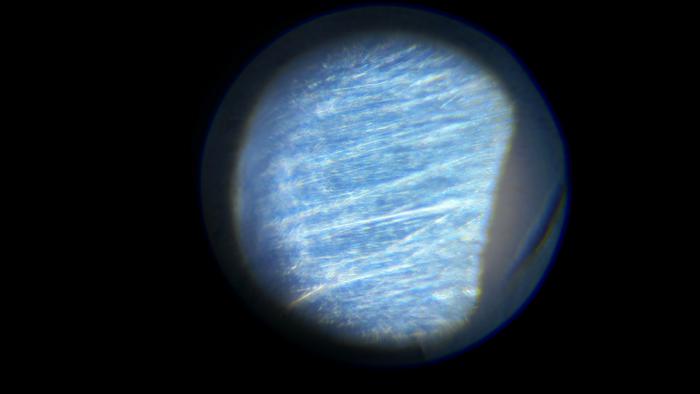
Now, I've mentioned before my Guangxi and Lynn Melynllyn have a very similar finish, but it's fairly apparent that edge of the Guangxi Is the "best" of the 5. Tomorrow I'll revisit the Welsh Slates with 50 strokes on shave lather each and see what the end result is. I suspect they'll all clean up well.
The Dragon's Tongue is the only somewhat unknown quantity. I've never finished on just that, so I'm curious to see how it looks and how it shaves. I imagine it should be equivalent to the feel of the Norton 8K.Last edited by Marshal; 02-13-2016 at 02:29 PM.
-
02-13-2016, 11:15 PM #2Senior Member



- Join Date
- Dec 2014
- Location
- Virginia, USA
- Posts
- 2,224
Thanked: 481
As promised, more cell phone shenanigans today. A picture is worth a thousand words, so I'll keep it short. Same razors, same hone hones, same order. First the picture of the razor on it's hone, followed by the final scratch pattern. I'm sure we all recognize the yellow hone, an I took a better picture of the stria - same razor from yesterday, no extra attention.
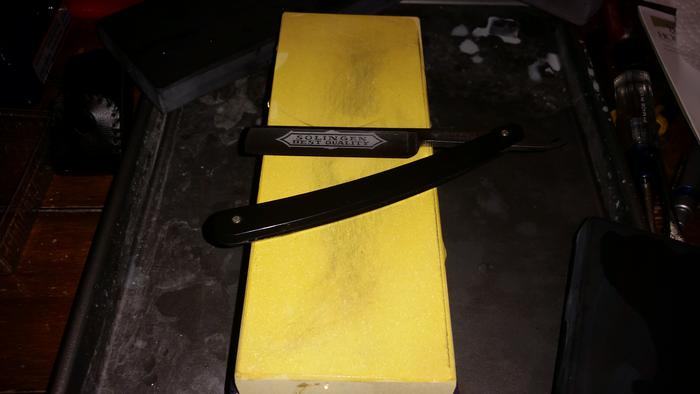
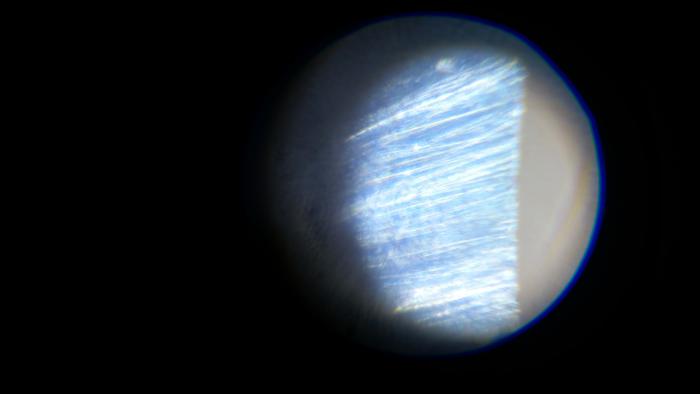
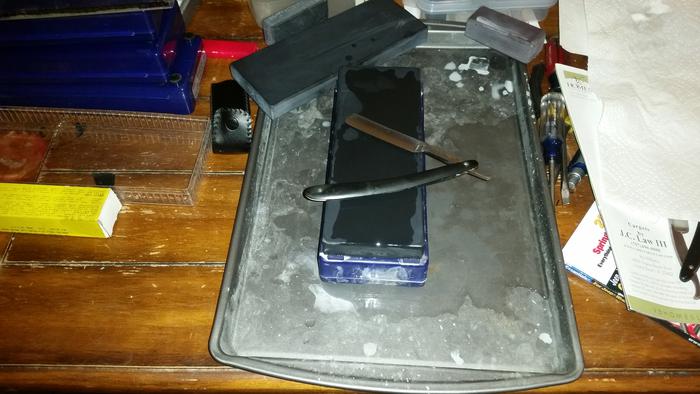
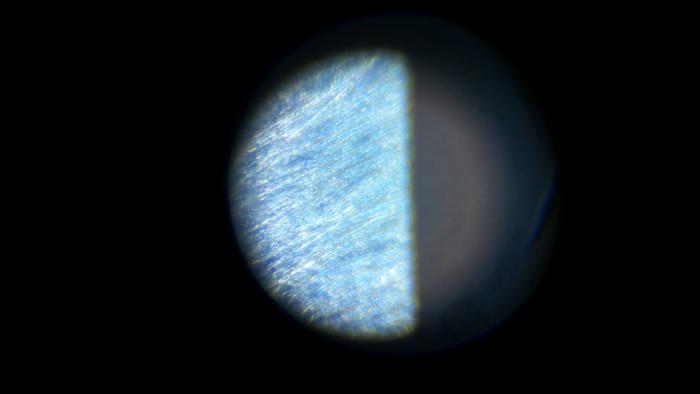
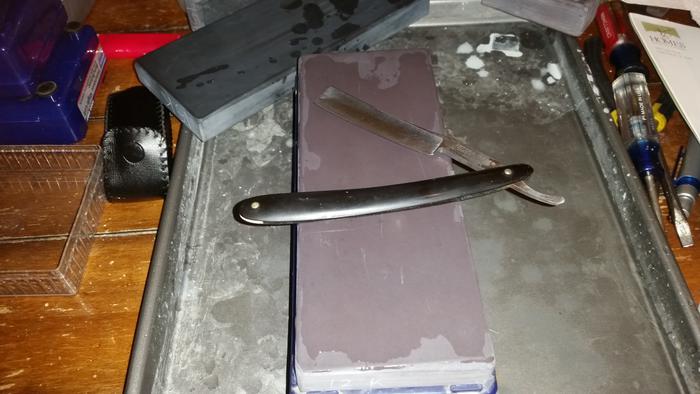

-
02-13-2016, 11:22 PM #3Senior Member



- Join Date
- Dec 2014
- Location
- Virginia, USA
- Posts
- 2,224
Thanked: 481
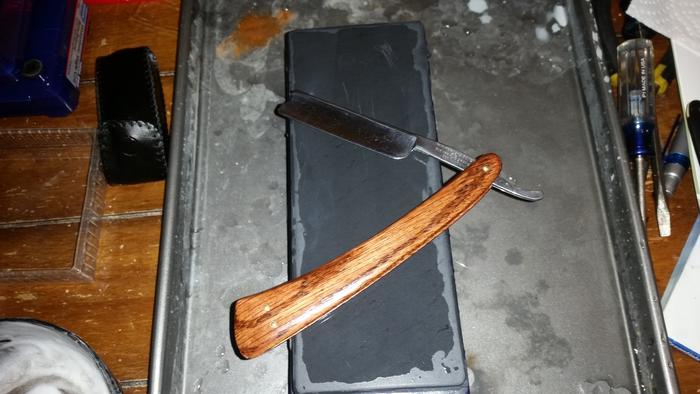
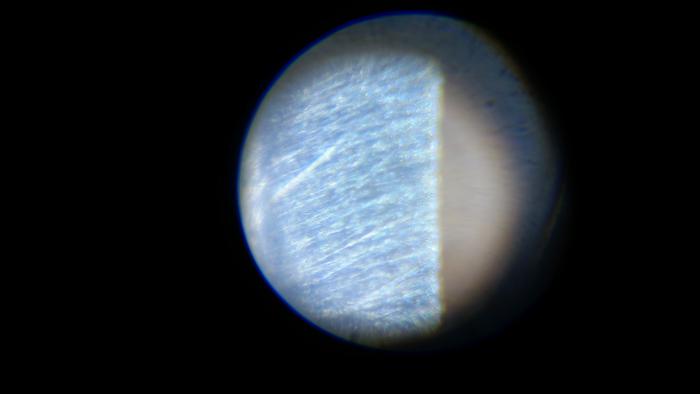
Well, there we have it. I'm of the opinion that the Dragon's Tongue is performing above the 8k level. Yes, there are more stria, but to me they look notably shallower. I'll probably shave with it later to form a more informed opinion.
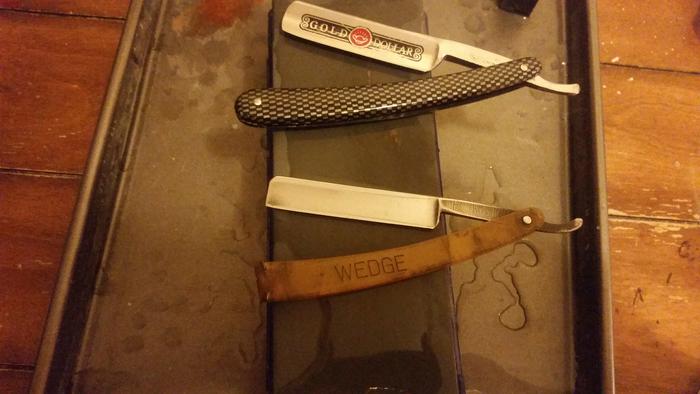
Had to throw one of the PHIG in there. Can't leave anyone out! Maybe tomorrow I'll play with my barber hones and see what's what there.
-
04-06-2016, 12:42 AM #4Senior Member



- Join Date
- Apr 2012
- Location
- Diamond Bar, CA
- Posts
- 6,553
Thanked: 3215
“I think AJ's numbers are a bit high, DT 6k, Purple 7-10k(maybe), Dark 10k+”
“The best I can say is Norton = DT < Purple slate = PHIG < Black slate. This is evidenced both by the feel of the edges on my face, and pictures of the stria taken at 200x magnification. Pictures can be found here:”
Ok, so if you want to grit rate “YOUR” stone, hone a razor on a synthetic stone of known grit, a quality synthetic, 8 or 12K, mark the edge with a line in the middle of the blade on both sides. Not hone the razor toe half, by keeping the halfway mark at the edge of the stone, so you are only honing half the blade.
Now compare the stria from each stone side by side until you find a grit that matches the known grit stone. Now you know what your stone is the grit equivalent of. And says nothing of any other stone of the type just that is what your particular example is.
Some natural stones can produce different grit from side to side.
Very few natural stones are close to 8k, fewer over 10k. The Welch slates I have tested are between the 4 & 8k grit range and nowhere as uniform in grit as vintage slates.
And that is the difference between the Welch stones and a quality vintage slates; uniform grit, high grit range, uniform release of grit or not and friability.
It is not just about the grit size, but grit size is important and often mis-represented and promoted by vendors and or lack of proper comparison. One cannot just pull a number out of air or say it feels like…
The photos are nice, but have to be compared to known grit, with the same razor and with the same preparation, preferably.Last edited by Euclid440; 04-06-2016 at 12:45 AM.
-
04-06-2016, 01:57 PM #5Senior Member



- Join Date
- Dec 2014
- Location
- Virginia, USA
- Posts
- 2,224
Thanked: 481
Good point. I'll have to select one and retry the experiment
-
06-03-2016, 12:13 AM #6Senior Member



- Join Date
- Dec 2014
- Location
- Virginia, USA
- Posts
- 2,224
Thanked: 481
So today I got 2 Arkansas stones in, a Best Brand soft and hard:
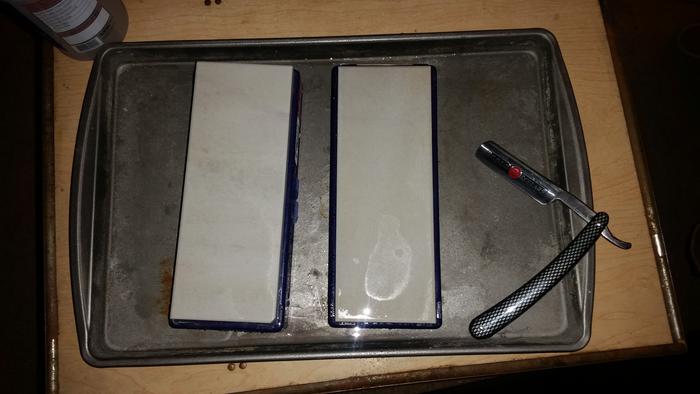
As you can see these 2 are very similar in color. In order to be able to tell the 2 of them apart, I nibbled at one of the corners of the Soft Arkansas. I checked them for flatness and to my surprise they were already just as flat as I would get them if I lapped them myself. Score one for Best brand hones. I did lap the surfaces a little bit with the DMT only to prepare the surface. The edges of one side are beveled, the other side are rounded.
The Gold Dollar is the guinea pig for this hand shaking experiment, and water is the medium of the day. I chose The Gold Dollar for 2 reasons - 1 I don't plan to shave with it anytime soon and 2: I used it to cut things I shouldn't have and it needed bevel work anyway. I opted to compare these 2 to the Norton 1K because soft and hard hones are on the low end of the scale. No point comparing them to 8K, and both should be a degradation from 4K. As before the pictures are at about 200x magnification. Anyway, without further ado, the Gold Dollar edge after setting the bevel on the Norton 1K:
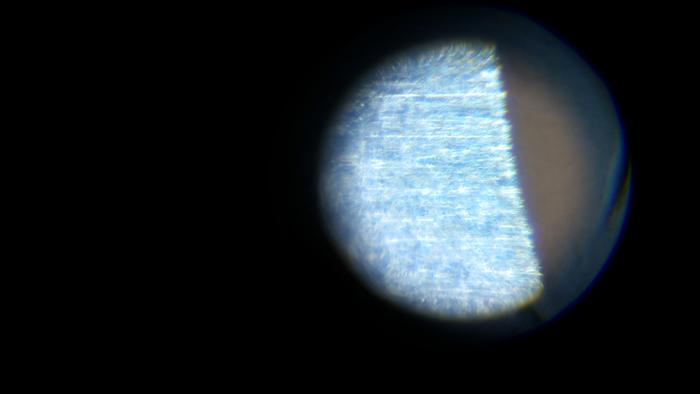
There's a lot of scratches for the camera to refract off of, so I really had a hard time getting a half decent picture. That was about the best I could pull off. Well, onward we go, to the Soft Arkansas:
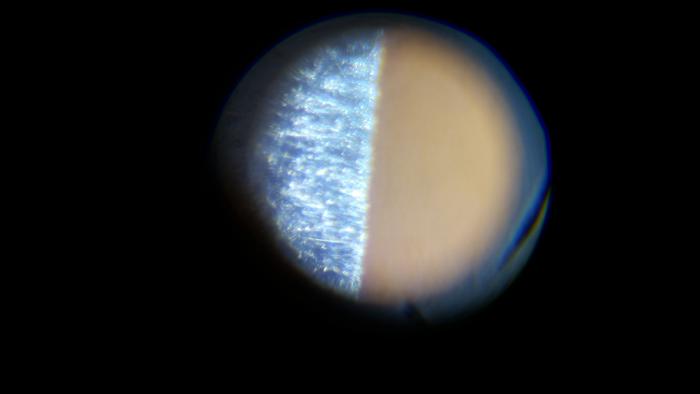
To my surprise, this is an improvement over the 1K, the only way you can tell is the presence of more blue fuzz (flat steel) than white fuzz (scratches). My Photography needs more work than my honing. I was honestly expecting same performance or lower. I didn't really count exactly how many strokes I did. I kinda did the same thing I usually do, a set (ball park 20/10/5/3/2/1 back and forth passes then 10Xs) of 'heavy' strokes, a set of medium strokes, and halfway through the pass of light/no pressure strokes the blade started to stick to the hone. At that point I did 10 X's and stopped because it probably wasn't going to get any better. Then I moved on to the Hard Arkansas:
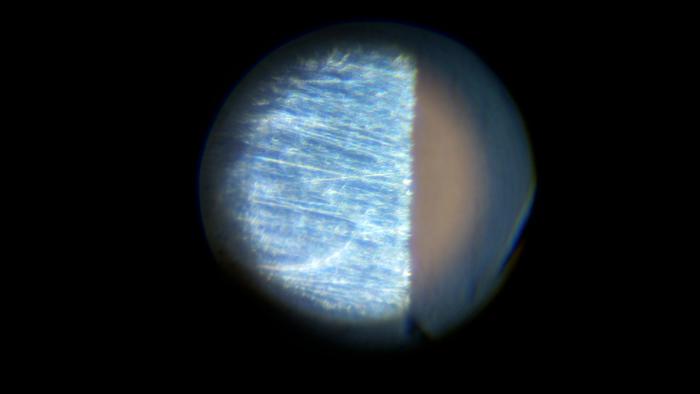
Same method as the Soft Arkie. But this time it took many more passes to feel a change. It started to get a little resistance after 2 'heavy' sets, then I lightened up to medium for 2 sets and it was feeling pretty sticky. 2 more sets with little/no pressure and it was feeling sticky like the Soft stone. Again, 10 X strokes and that was where I stopped.
My honest assessment is that I was surprised. I thought for sure I would be lapping the stuffing out of these. Again all they really needed was a little surface prep, 20 figure 8s with the DMT each just to get the surface where I wanted it. When I saw 2 (mostly) white stones I thought they had screwed around and sent me a pair of Soft hones. I know all grades have color variations, but the vast majority of Hards that I have seen are grey or black like the one I use for pocket knives. But it is an improvement above the Soft stone, and for a roughed up surface I think it did very well. I'm pleased with the pair of them. The way it pops hair off my arm I almost think I could strop and shave comfortably off the Hard stone.
At some point I may burnish the sides where I rounded the edges just to max out the hones for kicks and grins if nothing else. But first I think I'll do a little coticule slurry bevel setting experiment just to see what happens.
-
06-03-2016, 12:29 AM #7illegitimum non carborundum



- Join Date
- Jan 2008
- Location
- Rochester, MN
- Posts
- 11,552
- Blog Entries
- 1
Thanked: 3795
Is it possible for you to focus on the edge?


 8Likes
8Likes
 LinkBack URL
LinkBack URL About LinkBacks
About LinkBacks






 Reply With Quote
Reply With Quote